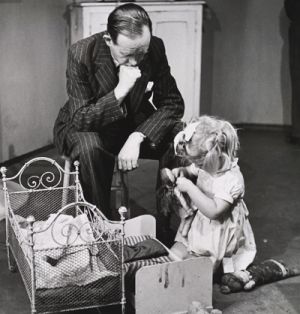One of our staff members is contributing considerably to a News Archiving service at Mu. Any well educated (Masters, PhD or above) users who wish to make comments on news sites, please contact Jim Burton directly rather than using this list, and we can work on maximising view count.
Attachment theory

Attachment theory is a long-established, but controversial and increasingly unpopular Freudian/evolutionary framework positing the importance of early bonds between infants and their primary caregivers. Developed by John Bowlby (1907–90), the theory posits that infants need to form a close relationship with at least one primary caregiver to ensure their survival, and to develop healthy social and emotional functioning.
A 2018 paper proposes that Attachment theory represents a Western middle-class perspective, ignoring the diverse caregiving values and practices in most of the world.[1]
Criticism
A 2013 study from Utah State suggests an individual can have different attachment styles in relation to different people and that "parents' time away from their child was not a significant predictor of attachment."[2] Attachment theory models are heavily focused on attachment to the mother, not other family members and peers, also noted by Rosjke Hasseldine.[3] Salvador Minuchin suggested that attachment theory's focus on the mother-child relation ignores the value in other familial influences: "The entire family—not just the mother or primary caretaker—including father, siblings, grandparents, often cousins, aunts and uncles, are extremely significant in the experience of the child...And yet, when I hear attachment theorists talk, I don't hear anything about these other important figures in a child's life."[4]
Quotes
Dr. Jerome Kagan:
Attachment is a far less popular explanation in 2019 than it was in the 1960s, and in 10 to 15 years, it's going to be rare to find anyone defending the theory. It's just dying out slowly...Yes, what happens to you in the first year or two of life has an effect, but it's tiny. If I take a 1-year-old child who is securely attached, and the parents die and the child is adopted by a cruel foster parent, that child is in trouble. Their secure attachment is useless.
[...]
Abuse and neglect in the first years are bad, but they’re associated with class. Children who are abused and neglected are far more likely to come from poor families than wealthy families. If you’re raised in a poor, single-parent family, you’re more likely to be abused. If you’re abused, you’re more likely to have problems when you’re 20. Now we’re quick to say it must be the abuse, but if you’ve been raised in poverty, you can’t dismiss that.
I’m suggesting that an abused child from a wealthy family of privilege would be far more likely to not have problems, because to be born into a disadvantaged class means you’re going to encounter different teachers, different schools, different peers, different values for the rest of your life. So we can’t just blame the abuse.[5]
Of relevance to MAPs
Attachment theory has been criticized for its use in stigmatizing non-normative sexualities:
Finally and most perniciously, the use of attachment theory has often been used to pathologize non-normative sexualities. Under the guise of relational "normality" established by a social construction of what a secure relationship looks like, folks have been labeled as insecurely attached simply for desiring sexual variety or displaying an interest in fetishistic activities. Hence, attachment-based therapists, especially those influenced by Freudian concepts, will often take on the stance that the security of their stable, long-term therapeutic relationship will not only change the client's attachment style, but in this way also transform the "sexual deviant" into a stable, sexually conforming member of society.[6]
See also
External links
References
- ↑ Keller H (November 2018). "Universality claim of attachment theory: Children's socioemotional development across cultures". Proceedings of the National Academy of Sciences of the United States of America. 115 (45): 11414–11419.
- ↑ Benware J. "Predictors of Father-Child and Mother-Child Attachment in Two Parent Families". Utah State University.
- ↑ Field T (February 1996). "Attachment and separation in young children". Annual Review of Psychology. 47 (1): 541–61. doi:10.1146/annurev.psych.47.1.541. PMID 8624142. S2CID 15251864.
- ↑ Wylie MS (March 2011). "Do We Still Need Attachment Theory?". Psychotherapy Networker.
- ↑ Barbaro N. "Rethinking the Transmission Gap: What Behavioral Genetics and Evolutionary Psychology Mean for Attachment Theory" (PDF). Psychological Bulletin. and Attachment Theory Is All Wrong. Here’s What The Science Really Says.
- ↑ Why Attachment Theory Is All Sizzle and No Steak (Psychology Today)